This post may contain affiliate links. Please read our disclosure policy.
Swap out your weekly stir-fry for this delicious Chinese eggplant recipe, the perfect veggie alternative that sacrifices none of the flavors. Packed with eggplant garlic sauce, you’d never guess this classic Chinese dish was gluten-free AND vegan.
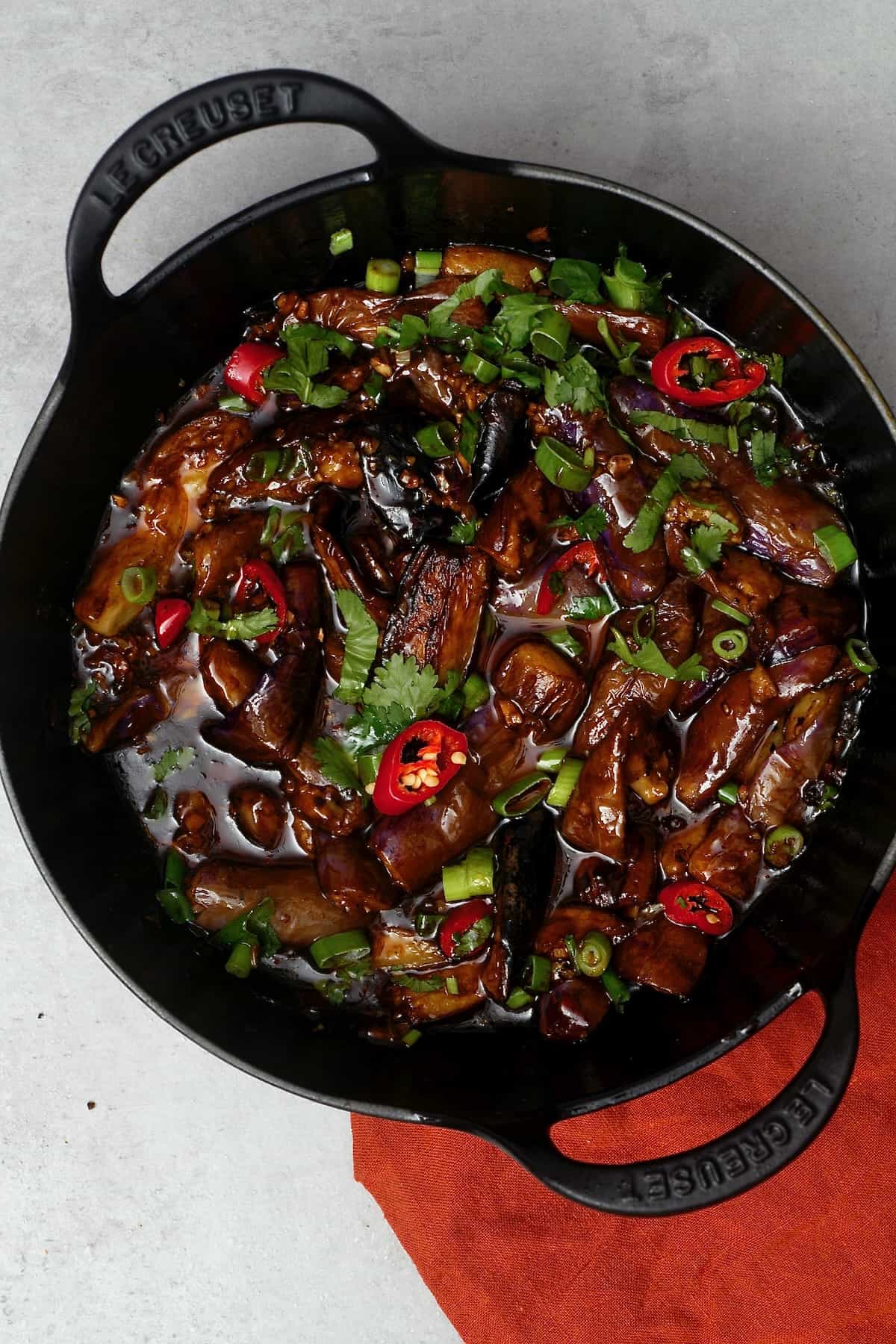
One of my favorite ways to serve one of my favorite vegetables is with a delicious Asian garlic sauce. It blends some of the most commonly used flavors in Asian cooking with a little Sichuan twist, which means plenty of spice – and plenty of delicious flavors. Garlic eggplant is a great way to dress up the veggie and help you get in your five a day. You can even add extra veggies to bulk it up with nutrients.
For this recipe, I am using Chinese eggplant, which is one of the longest eggplants you can buy, has fewer seeds, and has a mild, sweet flavor. This makes a great base for my eggplant recipe, as it blends well with the sauce and becomes tender and soft when cooked. No more boring stir fries for weekday dinners! Here’s how to make Chinese eggplant your favorite new dinner staple.
And if you’re looking for a comforting option, check out this eggplant stew for another cozy way to enjoy eggplant.
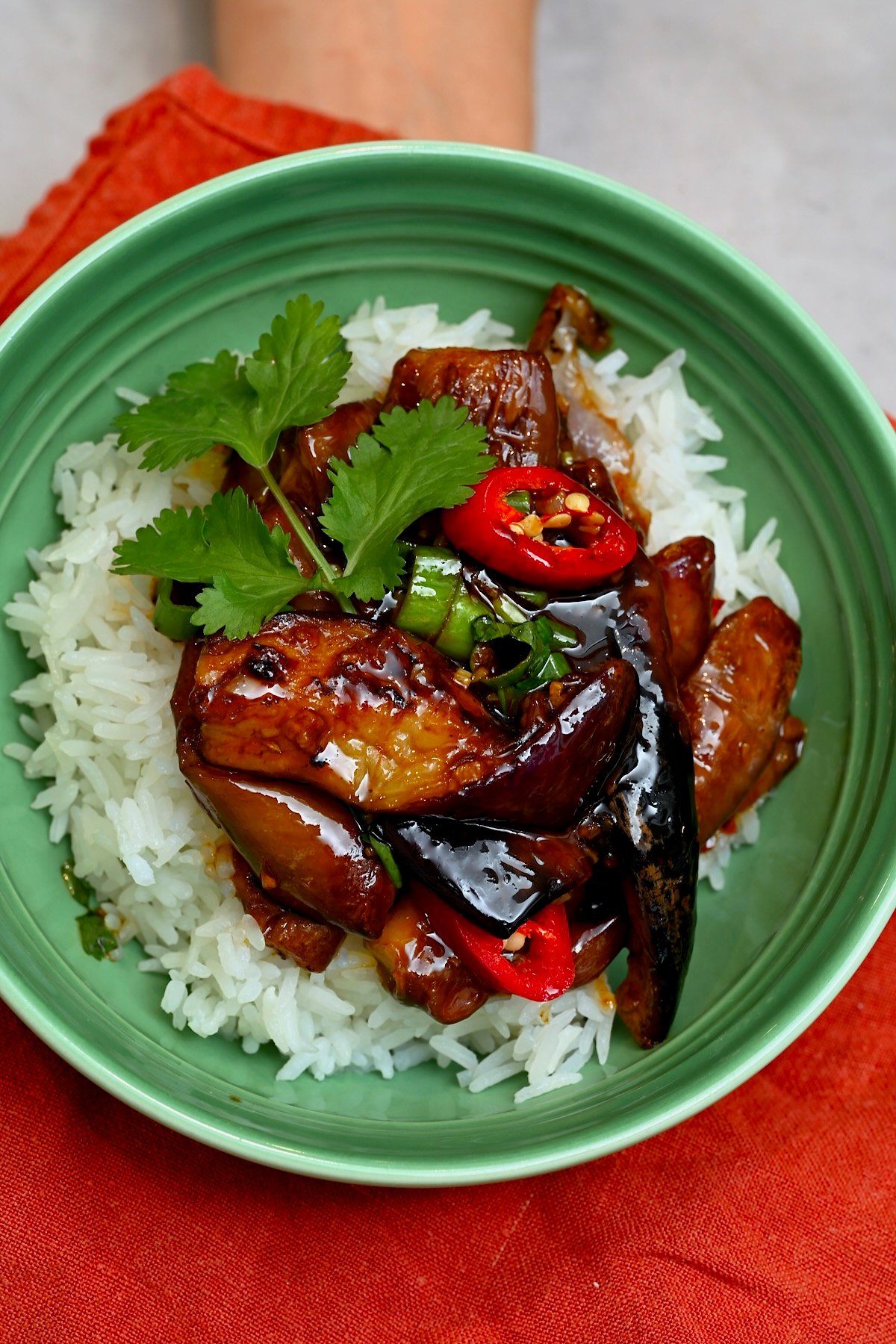
Want to save this recipe?
What Is Chinese Eggplant
Eggplant has been used in Chinese medicine for centuries, so it’s only natural it gets included in many of their meals. The typical Asian eggplant recipe is believed to come from the Sichuan region of China, where it’s served mixed with a thick, tangy garlic sauce infused with spices. Made in a skillet or wok, it’s a vegetarian mainstay in many Chinese restaurants.
What Type of Eggplant Should I Use
For this recipe, regular eggplants aren’t the best.
I love to use Asian eggplant – so Chinese or Japanese – in my Asian-inspired dishes. Chinese eggplants have fewer seeds and aren’t as bitter. If you’ve only got traditional eggplants to hand, they’ll do in a pinch.
But if you want the best, look for longer eggplants with a smooth surface and bright purple skin. It should look thin and be easy to bend. If it’s not, it’s likely not ripe yet – or the wrong kind of eggplant.
What Is the Difference Between Chinese Eggplant and Regular Eggplant
There are some key differences – the shape (long and thin vs stout and fat) and the general color (regular are a deeper purple and Chinese are lighter, more of a lavender color). A Chinese eggplant will have fewer seeds and a mild, sweet taste, whereas a traditional eggplant will have more seeds and a more bitter taste when it’s cooked.
Chinese Eggplant Ingredients
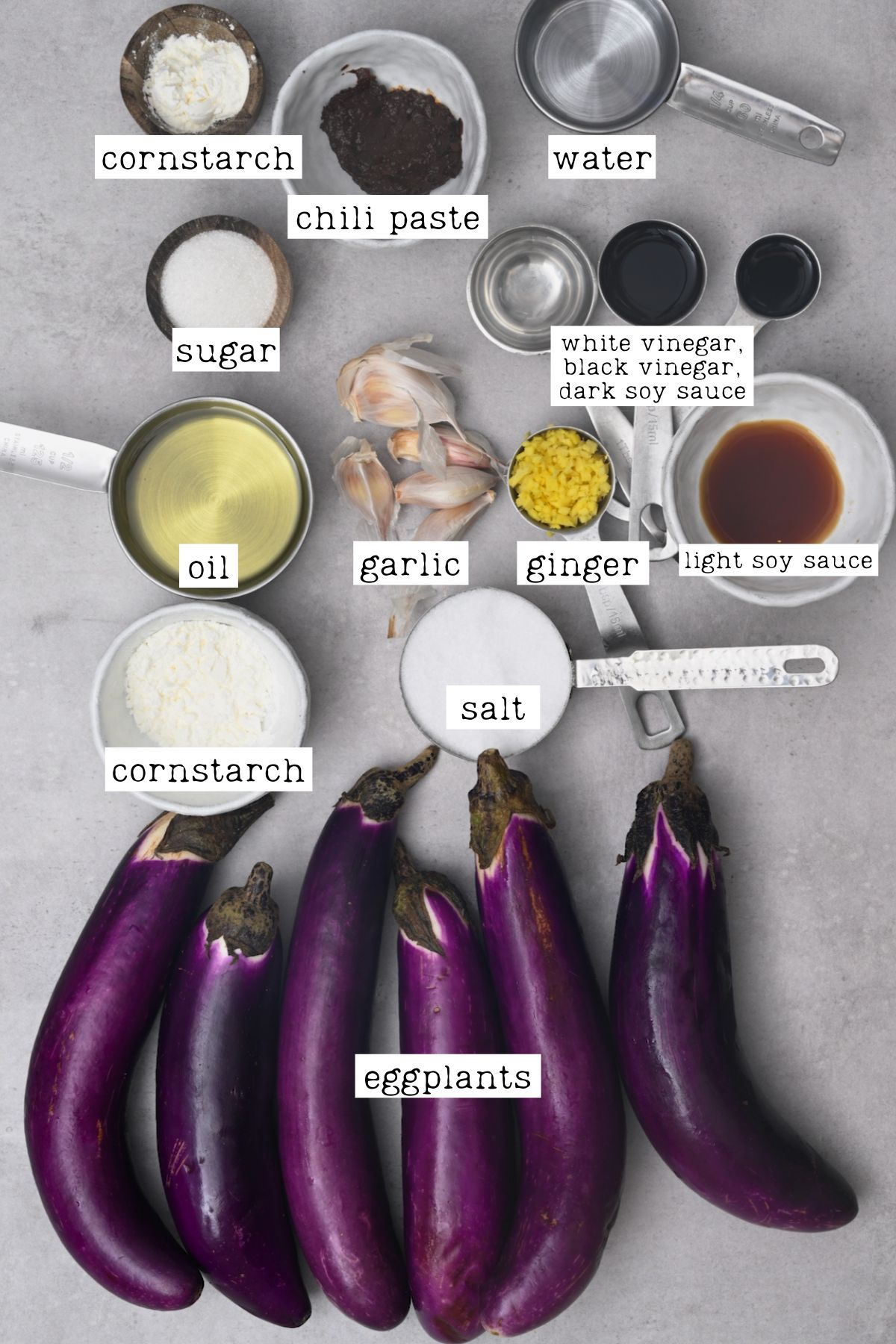
- Eggplant: I prefer to use Chinese or Japanese eggplant, though you can use traditional if you prefer. You’ll also need salt and water to brine it before cooking.
- Cornstarch: Or cornflour, this will coat the eggplant.
- Vegetable Oil: If you prefer, you can use peanut or sesame oil, or any kind of neutral cooking oil.
- Aromatics: I like using ginger and especially garlic (very useful for eggplant with garlic sauce).
- Chili paste: Use your favorite, that way you can adjust the heat levels. I like to stick to my homemade version.
- Sauce: To make the sauce, you’ll need Chinese black vinegar (or balsamic), white rice vinegar, light soy sauce (or shoyu), dark soy sauce, water (you can use chicken or veggie stock, but keep it low sodium), sugar and cornstarch.
- To garnish: I love to use green onions and red chili slices.
How to Cook Chinese Eggplant
There are just a few easy steps to make this delicious eggplant dish with spicy garlic sauce.
Prepare the Eggplants
Wash and dry the Asian eggplant. Then proceed with cutting the eggplant into quarters lengthwise, then into two.
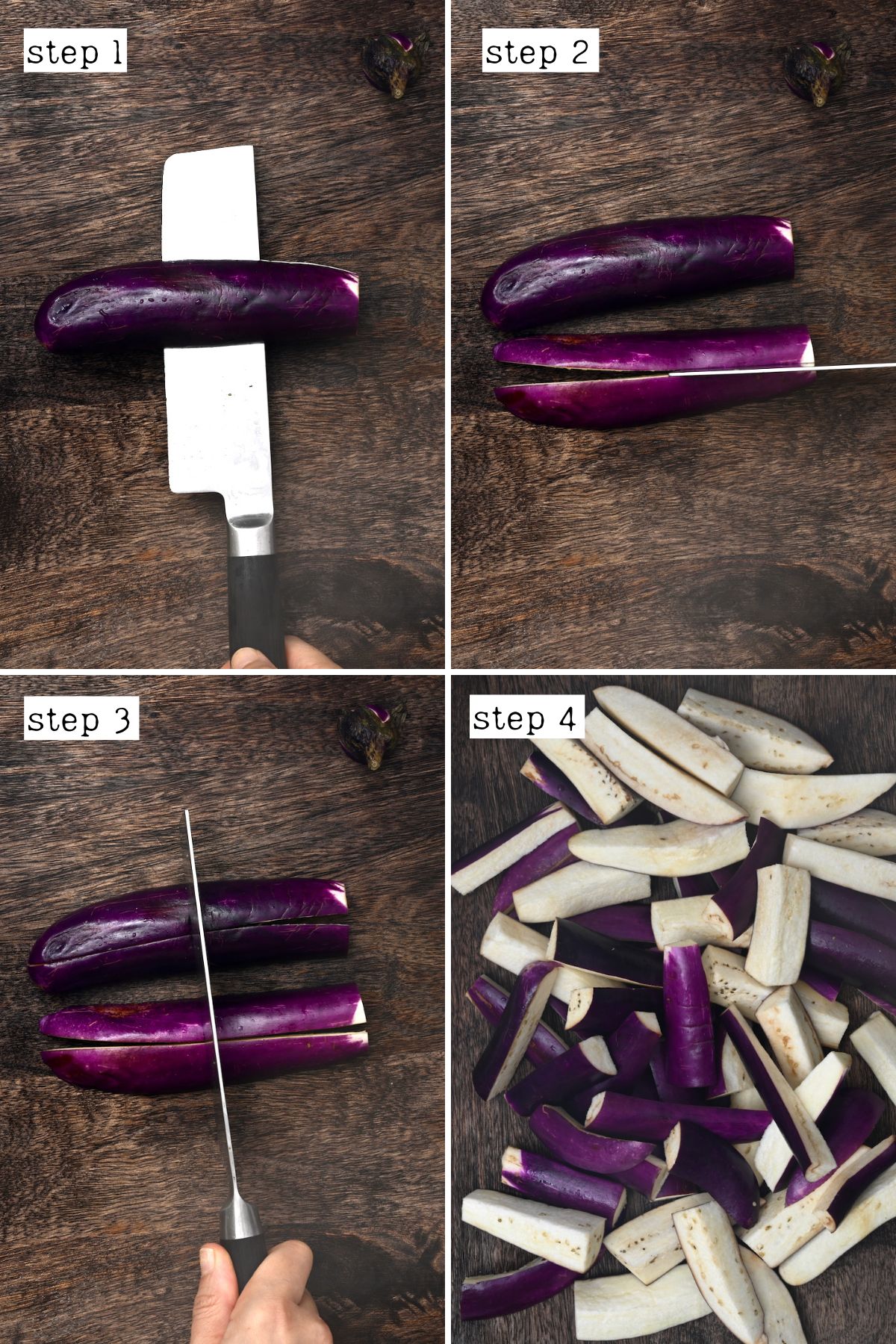
Then, brine the Chinese eggplant. To do this, mix water and salt in a large bowl until the salt has dissolved. Add the eggplants, then place a heavy object over the bowl to keep the eggplant submerged – like a lid or a plate/bowl. Set aside for 15- 20 minutes.
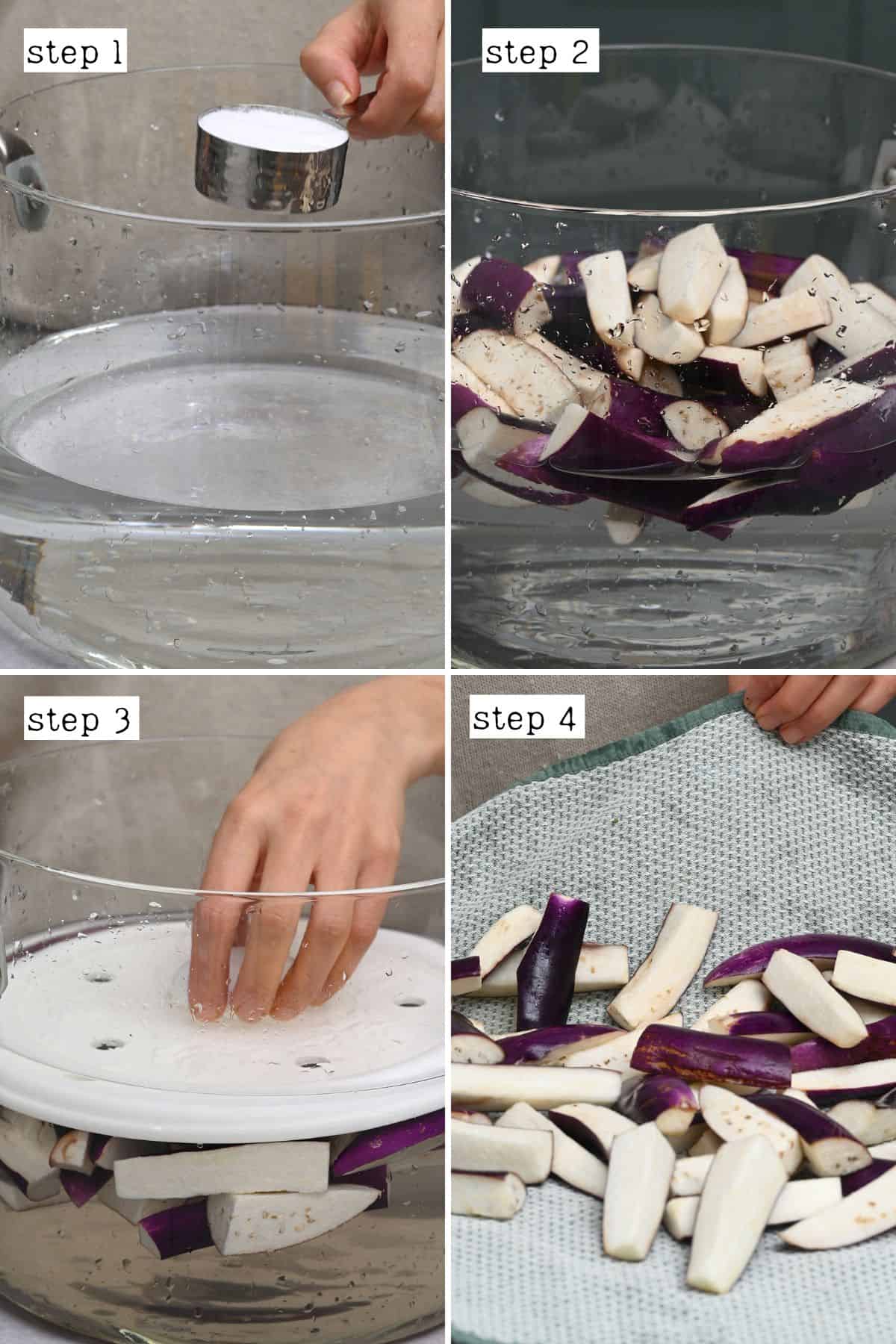
Drain and dry well. I like to spin them in a salad spinner first. Then, pat them dry with a clean kitchen towel.
Then, coat the eggplant with cornstarch – you can put it in a bowl and toss it together.
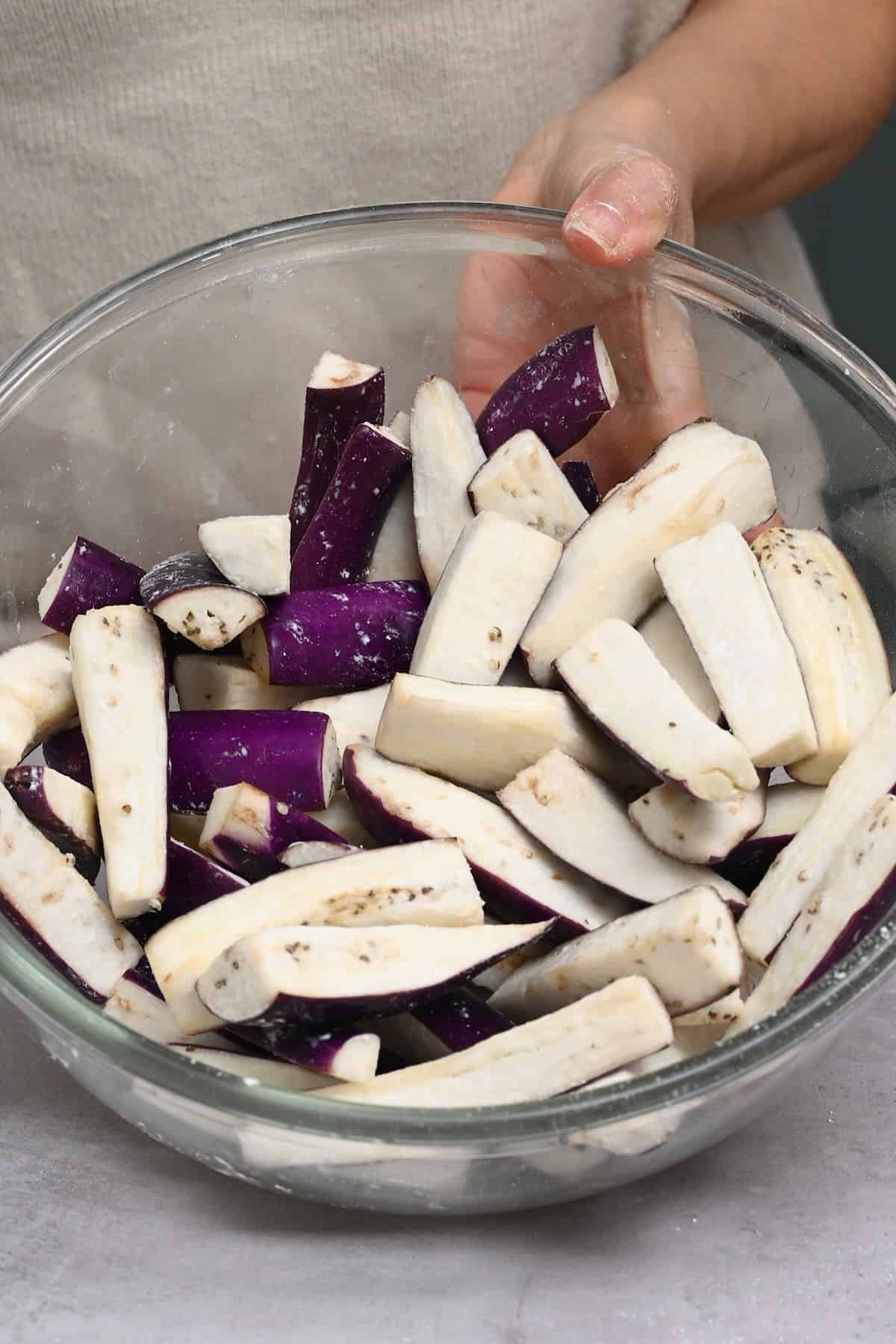
Prepare the Other Elements
As the eggplant is brining, measure out what’s needed of the other ingredients. Mince the garlic and ginger.
Make the sauce by mixing all the sauce ingredients in a small bowl and whisking well until there are no lumps.
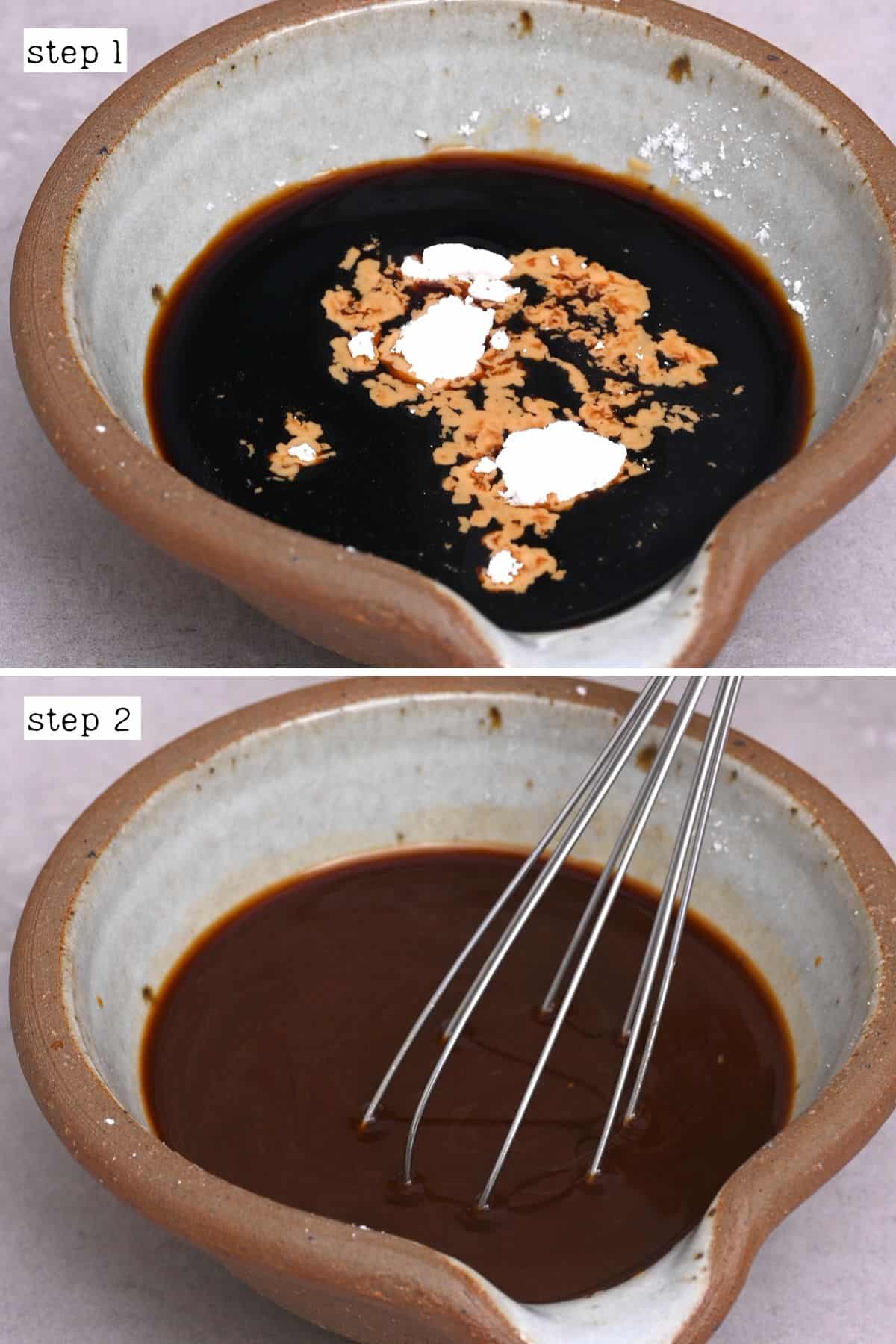
Cook the Eggplant
Heat a large pan or wok over high heat. Add half the oil and swirl it around the pan. Add the eggplant pieces in a single layer and reduce the heat to medium. Stir-fry and turn the pieces every minute until they are tender and browned on all sides.
This cooking process should take 4-5 minutes only. Once cooked, place the eggplant on an empty plate.
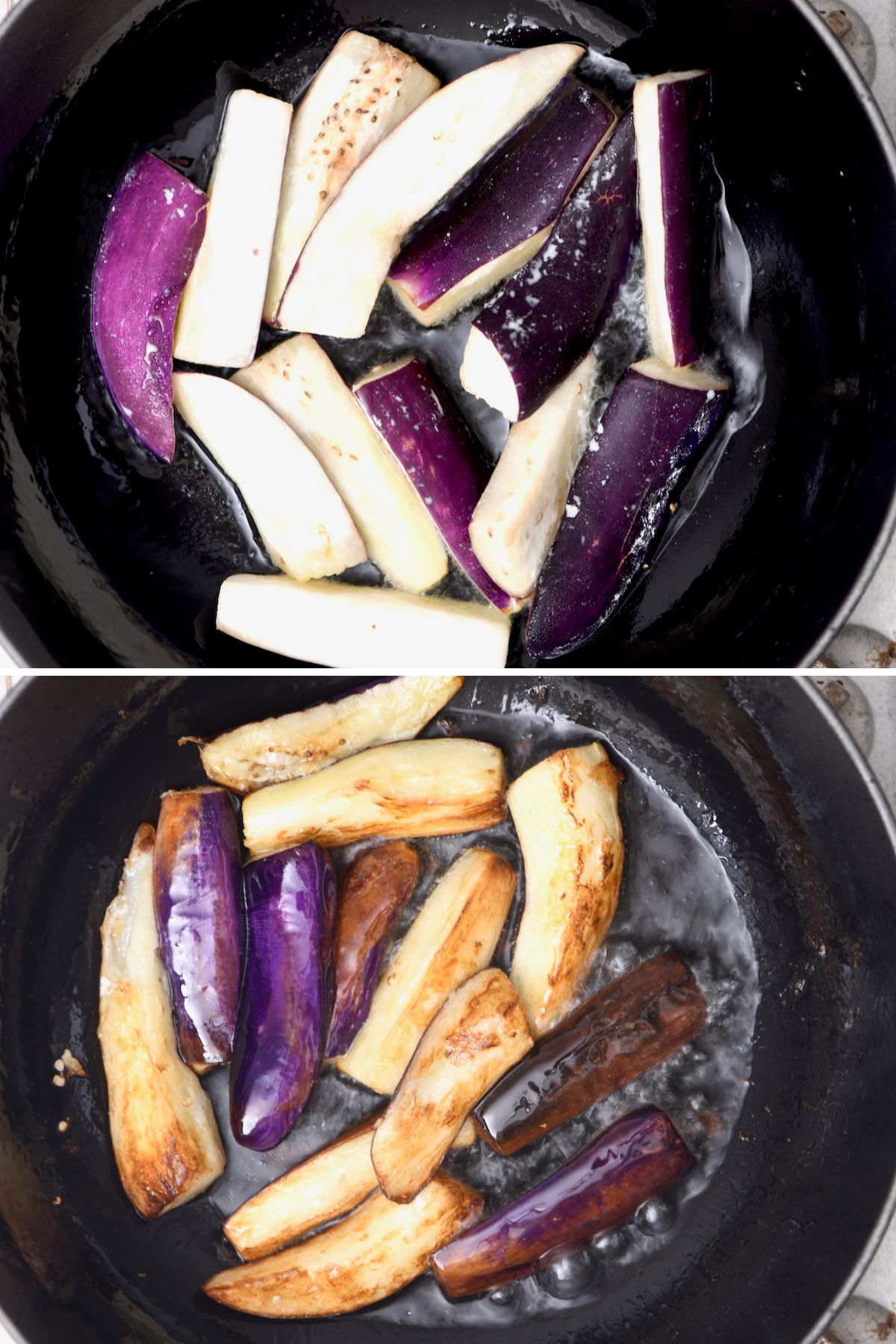
Increase the heat to high, add the remaining oil and swirl to coat the pan. Add the garlic, ginger, and chili paste, then stir-fry for 30-60 seconds.
Stir the sauce in the bowl to keep it mixed, then carefully pour it into the pan. Stir-fry for 15-30 seconds – the sauce should thicken and become glossy as it cooks. If it thickens too quickly, add a little water and allow it to cook off before serving.
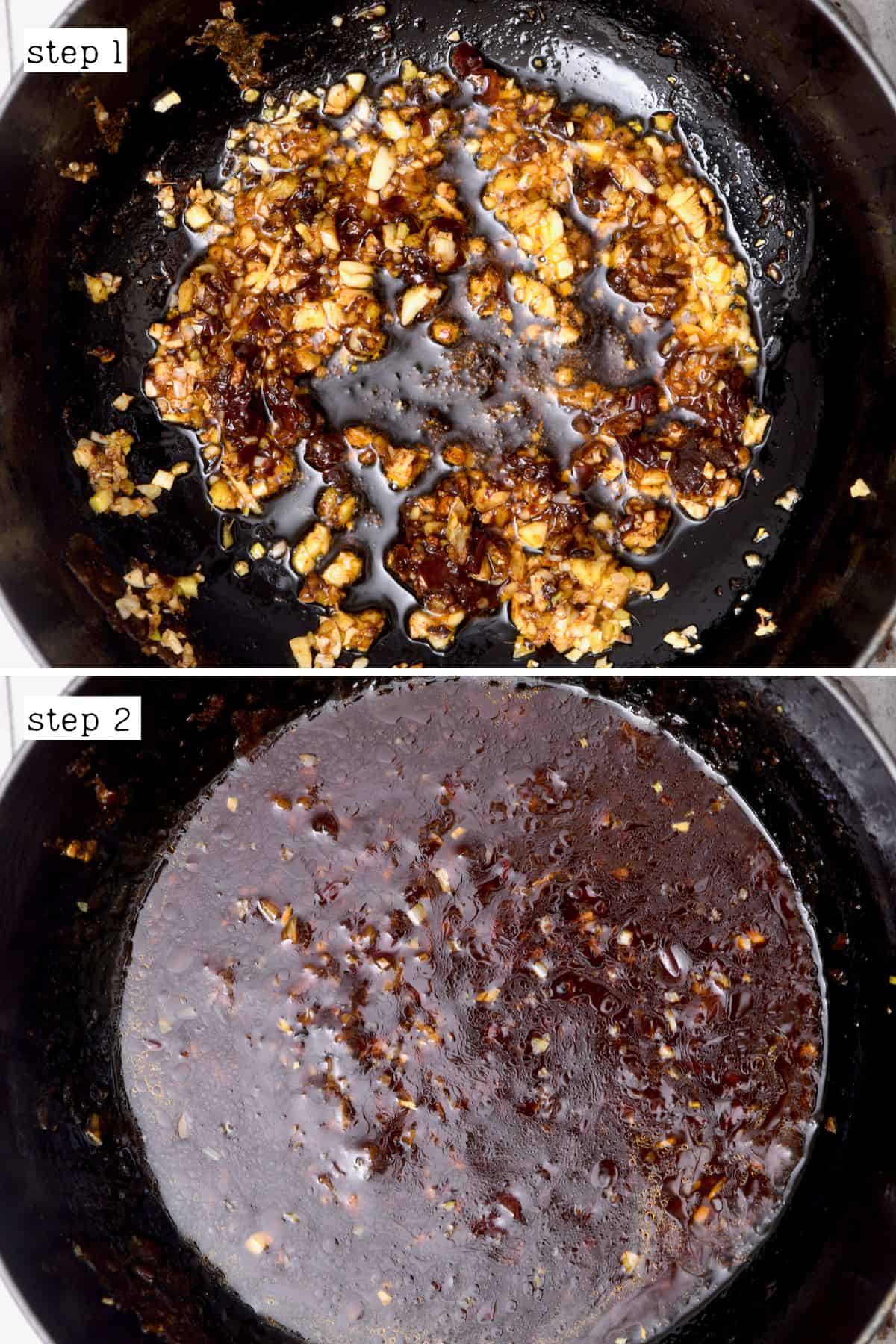
Return the eggplant to the pan. Toss to coat with the sauce. You only need to cook it for a further 1-2 minutes. Give the dish a taste and adjust any ingredients to taste.
Serve the Chinese garlic eggplant with rice, noodles, or as a side dish. You can top it with garnishes popular in Chinese eggplant recipes – I like scallions, cilantro, and red chili.
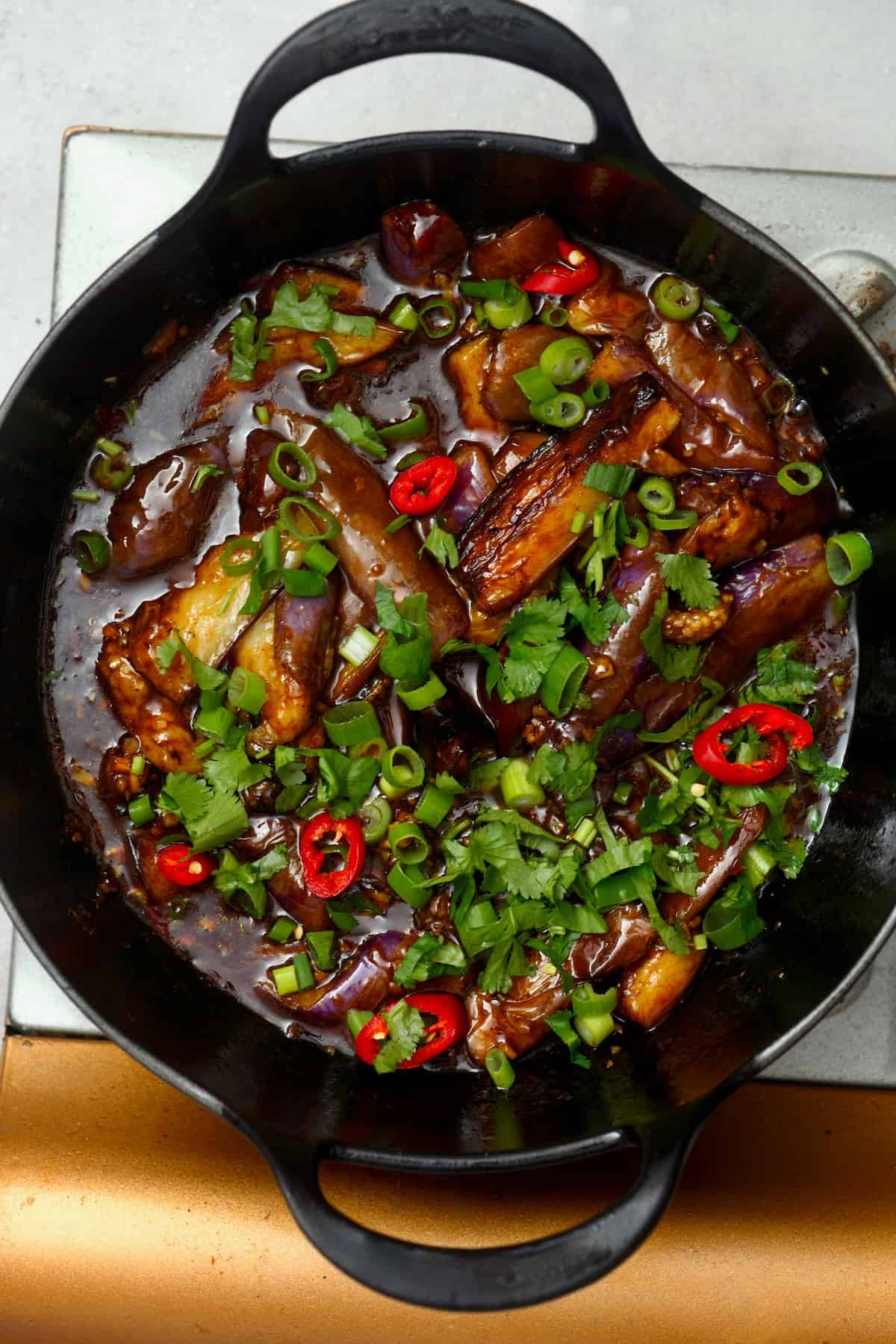
How to Store Chinese Eggplant
This eggplant garlic recipe can be stored both in the fridge and the freezer – though I’d always recommend you eat it when it’s fresh!
Cooked garlic Chinese eggplant can be kept in the fridge for 3-5 days after cooking. Store in an air-tight container or some strong freezer bags.
You can also store it in the freezer. You’ll want to make sure the Chinese eggplant garlic is completely cool before putting it in – this will help maintain the texture and taste. It can keep for up to six months, but I’d recommend eating it in a few weeks.
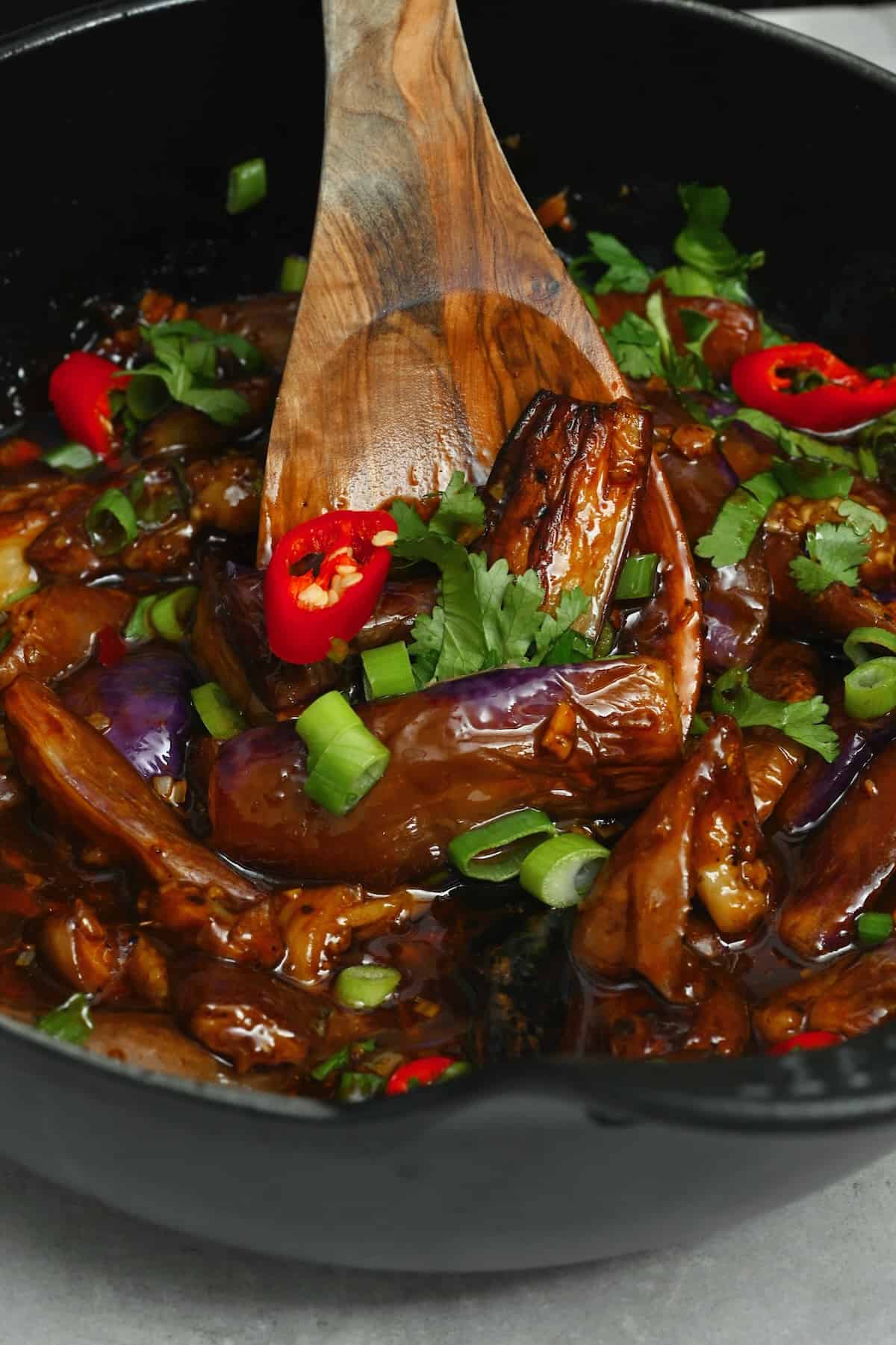
FAQs
Yes, you can. But, be aware that the taste and texture of the Chinese eggplant recipe will change if you use a traditional eggplant. Chinese eggplants are sweeter and softer, so they may also require less time in the pan.
Yes! The skin of Chinese eggplant, like ordinary eggplant, is harmless and adds flavor and plenty of color to the dish.
It depends on where you live. Some larger grocery stores may sell Chinese eggplant alongside the typical offering.
But, if you want the best vegetables, you should head to an Asian market or grocery store – you’ll know the produce is freshest there. Asian eggplant recipes are popular in many Chinese cuisine types, so they’re a staple offering at any good Asian market.
More Eggplant Recipes
- Oven Roasted Eggplant Slices
- Eggplant Salad
- Crispy Eggplant Chips with Honey
- Eggplant Tomato Dip
- The Best Eggplant Stew
If you try this spicy eggplant recipe, let me know how it goes in the comments below. I’d appreciate a recipe card rating and would love to see your recipe recreations – tag me on Instagram @Alphafoodie!
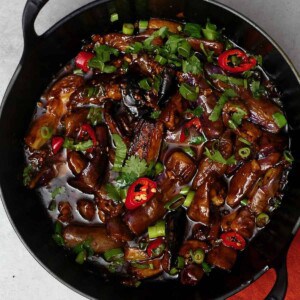
Authentic Chinese Eggplant Recipe
Equipment
- Large wok
Ingredients
- 22 oz eggplants best to use Chinese or Japanese (6 medium)
- 1.8 oz salt for soaking (1/3 cup)
- 4 cups water or enough to cover the chopped eggplants
- 0.35 oz cornstarch 1 Tbsp
- 1/2 cup vegetable oil divided
- 0.85 oz garlic 5 cloves
- 0.35 oz ginger 1 Tbsp minced/grated
- 0.7 oz chili paste your favorite (1 Tbsp)
For the Sauce
- 1 Tbsp Chinese black vinegar or balsamic vinegar
- 1 Tbsp white vinegar or rice vinegar
- 1 Tbsp light soy sauce or shoyu
- 1 Tbsp dark soy sauce
- 1/4 cup water or chicken/veggie low sodium stock
- 0.7 oz sugar 1.5 Tbsp
- 0.2 oz cornstarch 1/2 Tbsp
Instructions
Prepare the eggplant
- Wash and dry the Asian eggplant. Then proceed with cutting the eggplant into quarters lengthwise, then into two. (Refer to the images on the blog.)
- Brine the Chinese eggplant. To do this, mix water and salt in a large bowl until the salt has dissolved. Add the eggplants, then place a heavy object over the bowl to keep the eggplant submerged – like a lid or a plate/bowl. Set aside for 15- 20 minutes.
- Drain and dry well. I like to spin them in a salad spinner first. Then, pat them dry with a clean kitchen towel.
- Coat the eggplant with cornstarch – you can put it in a bowl and toss it together.
Prepare the remaining ingredients
- As the eggplant is brining, measure out what's needed of the other ingredients. Mince the garlic and ginger.
- Make the sauce by mixing all the sauce ingredients in a small bowl and whisking well until there are no lumps.If you are planning on making rice for this dish, you can start it while the eggplant is brining.
Cook the eggplant
- Heat a large pan or wok over high heat. Add half the oil and swirl it around the pan. Add the eggplant pieces in a single layer and reduce the heat to medium. Stir-fry and turn the pieces every minute until they are tender and browned on all sides. This cooking process should take 4-5 minutes only. Once cooked, place the eggplant on an empty plate.
- Increase the heat to high, add the remaining oil and swirl to coat the pan. Add the garlic, ginger, and chili paste, then stir-fry for 30-60 seconds.
- Stir the sauce in the bowl to keep it mixed, then carefully pour it into the pan. Stir-fry for 15-30 seconds – the sauce should thicken and become glossy as it cooks. If it thickens too quickly, add a little water and allow it to cook off before serving.
- Return the eggplant to the pan. Toss to coat with the sauce. You only need to cook it for a further 1-2 minutes. Give the dish a taste and adjust any ingredients to taste.This Chinese eggplant stir-fry is best enjoyed over rice or noodles. You can top it with green onions, scallions, red chili, and some sesame seeds before serving.
Storage Instructions
- It's best to enjoy this dish fresh. Store any leftovers in the refrigerator, covered for between 3-5 days. Alternatively, you can freeze for up to 6 months.Reheat the garlic eggplant dish in the microwave or on the stovetop, optionally with a splash of water to thin the sauce once more.
Notes
- Adjust the spice: feel free to reduce/increase the chili paste to adjust the spice levels to your personal preference.
- Adjust sauce ingredients: in general, most of the sauce ingredients can be adjusted to personal preference (soy for saltiness, sugar for sweetness, etc.)
- Other vegetables: there are several other veggies you could add, including julienned carrots, mushrooms (shiitake or others), and sweet/bell peppers.
- Nuts: instead of the sesame seeds, you could top off the stir-fried eggplant with lightly toasted cashews or peanuts.
- Aromatics: in terms of the sauce, there are several ways you can increase flavor – for example, with oyster sauce or hoisin sauce.
- Protein: instead of or alongside the eggplant, you could add tofu or chickpeas for added protein.
Nutrition
Nutrition information is automatically calculated, so should only be used as an approximation.










This ŵas exactly how I imagined it would be. Perfect! I sautéed up a red pepper and viadlia onion and added that to the cooked eggplant. Served with sticky rice and…well…yum!!!
Thank you so much for your comment, Brenda! I’m so glad to hear you enjoyed it! Happy cooking!
Better then the stuff I find at local restaurants! This recipe is a keeper!
Glad you liked it, Candace! Thanks for commenting.
This was delicious! I made a few changes: added carrot and sweet red pepper, as well as 1/2 lb. ground chicken for protein. Instead of frying the eggplant, I roasted it. I also doubled the sauce, using mirin instead of sugar. And topped it all with roasted cashews. We will make this again! Thanks so much for the recipe!!!
Glad you liked it, Kathy!
Don’t substitute balsamic for black vinegar. If you can’t find black vinegar just leave it out.
Thanks for the tip, Chris!
I had tried another person’s recipe but yours is the one I was looking for and that I remember being closest to dishes I’ve eaten in Asian restaurants. Quite good tho I Didn’t have the chili paste or light soy sauce. It was good and I appreciate the step by step photos! Will def make it again!
Glad you liked it, Susie!
Fantastic! Thank you! This turned out great even though I added a few extra Chinese sauces. This has always been my favorite Chinese recipe and now I can make it myself anytime. Really, thank you very much! I love the sweet and spicy with the eggplant!
Glad to hear you liked it, Donna!